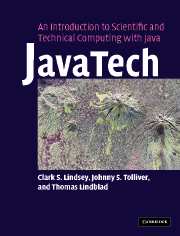Book contents
- Frontmatter
- Contents
- Preface
- Acknowledgements
- Part I Introduction to Java
- Part II Java and the network
- 13 Java networking basics
- 14 A Java web server
- 15 Client/server with sockets
- 16 Distributed computing
- 17 Distributed computing – the client
- 18 Java Remote Method Invocation (RMI)
- 19 CORBA
- 20 Distributed computing – putting it all together
- 21 Introduction to web services and XML
- Part III Out of the sandbox
- Appendix 1 Language elements
- Appendix 2 Operators
- Appendix 3 Java floating-point
- Index
- References
21 - Introduction to web services and XML
Published online by Cambridge University Press: 08 January 2010
- Frontmatter
- Contents
- Preface
- Acknowledgements
- Part I Introduction to Java
- Part II Java and the network
- 13 Java networking basics
- 14 A Java web server
- 15 Client/server with sockets
- 16 Distributed computing
- 17 Distributed computing – the client
- 18 Java Remote Method Invocation (RMI)
- 19 CORBA
- 20 Distributed computing – putting it all together
- 21 Introduction to web services and XML
- Part III Out of the sandbox
- Appendix 1 Language elements
- Appendix 2 Operators
- Appendix 3 Java floating-point
- Index
- References
Summary
Introduction
Over the last few years, a new distributed computing technology based on the now-ubiquitous World Wide Web and known as web services has become very popular. In this chapter we introduce web services and briefly discuss how the technology can be used in a scientific application. We also introduce the closely-related Extensible Markup Language (XML). These are both large subjects. A full treatment is outside the scope of this book, but this chapter is designed to give the interested reader enough basic information to get started and pointers on where to look for more.
Introducing web services for distributed computing
We have already learned about distributed computing in the abstract sense using UML in Chapters 16 and 17. And we've learned concrete implementations using Java RMI in Chapters 18 and 20 and CORBA in Chapter 19. Both RMI and CORBA are technologies invented to implement distributed computing. One can think of both as transport mechanisms used to move data and, at least in the case of RMI, objects from clients to servers and back. There are other technologies for distributed computing as well, such as the low-level socket based networking technologies discussed in Chapters 14 and 15, and higher-level proprietary single-platform technologies, particularly Microsoft® products, that are not of interest to this book. Web services offer another alternative technology for distributed computing.
- Type
- Chapter
- Information
- Publisher: Cambridge University PressPrint publication year: 2005



